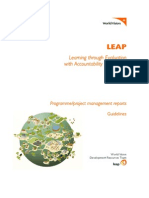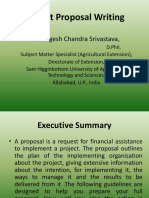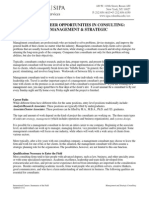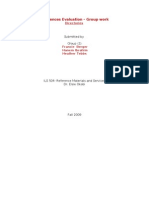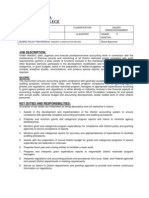Proposal Components
Uploaded by
Abdul RahmanProposal Components
Uploaded by
Abdul RahmanProposal components
Key Proposal Components
If a grantmaker does not provide a form or specific outline for the proposal, we
recommend you use the following structure:
Abstract or Executive Summary: Initial reviews are often based on the
abstract (approximately 200 words) or executive summary (one to two pages).
Write either as a stand-alone piece for an audience of educated lay-readers.
Cover Letter: Like an executive summary, the cover letter should summarize
the project and serve as a brief overview of the requested amount, goals,
objectives, and methods. Use the letter to show that you understand the grant-
maker's program and how your project fits into it.
Introduction: Briefly state the goal of your research project, provide an
overview of how you intend to carry it out, and include the amount you are
requesting. Throughout the narrative, draw connections between your goals
and those of the grantmaker.
Needs Statement/Statement of Significance: Place your needs statement
near the beginning of the proposal so that reviewers immediately understand
why the project is important.
Present the problem as something that you can solve.
Include empirical data and comments from leaders in the field.
Be positive. Focus on the project's impact, not on the challenges you
face.
Avoid circular logic, in which the lack of a solution is the problem.
Describe who will benefit and how they will benefit.
Professional/Institutional Qualifications: Describe your qualifications to
undertake the project. Provide evidence of the institution's commitment to your
project or field of study and the institutional strengths that will support your
project's success. If applicable, describe results from prior agency support.
Literature Review/Project Background: Put your project in context. What
aspects of the problem have others addressed? What do you plan to build
upon? What makes your project unique? Why is it the next logical step in
addressing the problem?
Goals and Objectives: Transition from stating the problem to offering a
solution. Begin with a set of goals and objectives that you intend to work
toward.
A goal is a general statement about the aim of a project. "To contribute
new knowledge to the field of..." "To expand the curriculum in the area
of..."
Objectives are indicators of whether a project is successfully working
toward the overarching goal. An objective describes the specific
outcome of a project and can be indicated by a measurable change
(increase or decrease) or a final product (scholarly article, data set, new
technique).
Project Description: This is the heart of the proposal and should be the
longest part of the narrative.
Describe and defend your methods.
Outline the project in a logical sequence of events.
Include a chart or graph to illustrate the timeline.
Demonstrate that you have the resources to accomplish the project:
Describe personnel, equipment, facilities, external specialists, experts,
institutional resources, and other external funding sources.
Sustainability: Describe if and how the project will continue after funding. Are
there specific start- and end-dates? If not, will it continue to be financially
viable?
Assessment: Do not overlook this increasingly important proposal
component. Describe your plans to evaluate what worked, what didn't work,
and why. Some accepted forms of assessment include measurable outcomes,
peer-reviewed publications, and outside consultant review.
Dissemination: Describe who will benefit from the knowledge gained as a
result of the project. How will you let them know about it? Might your project's
methods and/or outcomes be incorporated into the work of others?
Conclusion: In one or two paragraphs, make a final appeal for your project.
Restate the main points of your proposal. Tie your project again to your long-
range goals and to the goals of the grant-maker.
Budget: The budget reflects the full scope of the project. Don't overstate the
cost of your project, but don't understate it either. Rather, present an accurate
reflection of the financial resources required to meet your goals. Include
income such as other external support, institutional support, and matching
funds. Include expenses for all project components, with narrative
explanations where necessary.
You might also like
- Manual Setting Up and Running A Toy LibraryNo ratings yetManual Setting Up and Running A Toy Library21 pages
- Portage Lake Watershed Support Grant ApplicationNo ratings yetPortage Lake Watershed Support Grant Application9 pages
- What You Need To Know To Transition From The Classroom To Competitive Employment100% (1)What You Need To Know To Transition From The Classroom To Competitive Employment55 pages
- How To Write A Proposal For A Project ExamplesNo ratings yetHow To Write A Proposal For A Project Examples3 pages
- PHASE 1 Project Identification and PlanningNo ratings yetPHASE 1 Project Identification and Planning7 pages
- Grant Writing Manual (Writing Reviewer-Friendly Grant Applications)No ratings yetGrant Writing Manual (Writing Reviewer-Friendly Grant Applications)67 pages
- Program Evaluation: A Brief Introduction ..No ratings yetProgram Evaluation: A Brief Introduction ..13 pages
- Knowledge Mobilization Strategy (SSHRC, 2009)No ratings yetKnowledge Mobilization Strategy (SSHRC, 2009)7 pages
- Ips On Riting Roposals: - O OUR Omework and LAN Head Be InformedNo ratings yetIps On Riting Roposals: - O OUR Omework and LAN Head Be Informed10 pages
- Gender Concerns in Education: Prof. Gouri Srivastava Head Department of Gender Studies, NCERTNo ratings yetGender Concerns in Education: Prof. Gouri Srivastava Head Department of Gender Studies, NCERT27 pages
- Core Funding Strategies: What Are Core Costs?No ratings yetCore Funding Strategies: What Are Core Costs?8 pages
- Proposal Writing Fundraising Training Workshop26850% (1)Proposal Writing Fundraising Training Workshop26854 pages
- Community Capacity Building Program: Proposal WritingNo ratings yetCommunity Capacity Building Program: Proposal Writing33 pages
- Resource Mobilization and Proposal Writing1No ratings yetResource Mobilization and Proposal Writing143 pages
- NM State University Grant Proposals and ExamplesNo ratings yetNM State University Grant Proposals and Examples48 pages
- Prs ACEVO Strategic Financial Management (Apr 07) FinalNo ratings yetPrs ACEVO Strategic Financial Management (Apr 07) Final40 pages
- Conducting Interviews - Tips For Conducting Program Evaluation Issue 11, Fact SheetNo ratings yetConducting Interviews - Tips For Conducting Program Evaluation Issue 11, Fact Sheet4 pages
- Career Op Consulting Management and Strategic NonprofitNo ratings yetCareer Op Consulting Management and Strategic Nonprofit4 pages
- Mobilizing Savings: Key Issues and Good Practices in Savings Promotion100% (1)Mobilizing Savings: Key Issues and Good Practices in Savings Promotion41 pages
- 8 Essential Values for Academic Leaders: A Quality Management ChecklistFrom Everand8 Essential Values for Academic Leaders: A Quality Management ChecklistNo ratings yet
- Learning Lab - A Proposal Writing Short CourseNo ratings yetLearning Lab - A Proposal Writing Short Course9 pages
- Allan and Nesta Ferguson Charitable SettlementNo ratings yetAllan and Nesta Ferguson Charitable Settlement34 pages
- How We Base Our Fee Schedules For Grant Writing Services100% (3)How We Base Our Fee Schedules For Grant Writing Services5 pages
- PBAS Proforma - Academic Performance Indicators (Research and Academic Contributions)No ratings yetPBAS Proforma - Academic Performance Indicators (Research and Academic Contributions)15 pages
- Managing Nonprofit Organizations in a Policy Worlddownload100% (1)Managing Nonprofit Organizations in a Policy Worlddownload56 pages
- Undergraduate Fees & Funding Guide - 2021 EntryNo ratings yetUndergraduate Fees & Funding Guide - 2021 Entry12 pages
- Financial Sustainability Within UK Charities: Community Sport Trusts and Corporate Social Responsibility PartnershipsNo ratings yetFinancial Sustainability Within UK Charities: Community Sport Trusts and Corporate Social Responsibility Partnerships24 pages
- Call For Application Travel Grants Spring 16No ratings yetCall For Application Travel Grants Spring 163 pages
- Government Grants and Loans: Free Money From The Government100% (5)Government Grants and Loans: Free Money From The Government2 pages




































